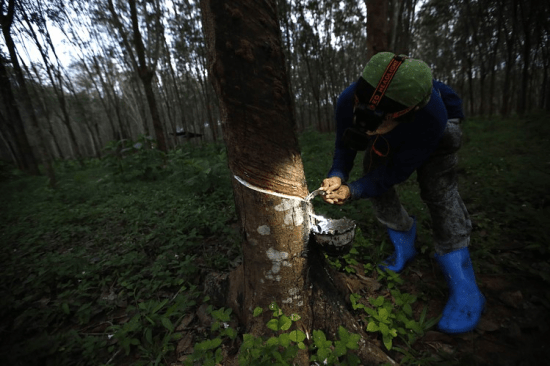A rally in the price of rubber is losing steam, underscoring the challenges major producers in Southeast Asia are facing after putting together a coordinated plan to shore up the market.
Five rubber associations across the region in early October agreed to not sell at prices below the cost of production to prevent oversupply and reverse a 37% plunge from the start of the year until early last month.
Prices rallied 10% during October, but are up just 1.5% in November as the ban has proved hard to enforce, with millions of farmers spread out over the region and many living from hand to mouth–meaning they have to sell to get urgently needed cash–said Indonesian Rubber Producers Association Chairman Daud Husni Bastari. Even middlemen such as processors have been forced to sell to keep their businesses running, said traders.

Global natural-rubber futures on the Tokyo Commodity Exchange closed at 205.1 yen ($1.73) a kilogram Friday, 2.1% higher from a week ago after the Japanese yen tanked to seven-year lows, giving some support after prices fell as much as 5% last week.
“Given that the rubber industry is highly fragmented, producers have been unable to ‘manage’ a cut in rubber supplies to a level low enough to support prices,” Macquarie Research said in a recent report. Given “an absence of price discipline by producers,” any gains would be limited, the bank said.
The region dominates the natural-rubber trade, accounting for about 80% of the world’s supply of the commodity, which is used in the manufacture of tires and gloves.
The International Rubber Consortium–a cartel comprising major producers Thailand, Indonesia, and Malaysia—over the years has indicated that discussions have been continuing among industry officials about stronger moves to prop up the market in the long run. Officials involved say the plans have been slow to move as varying political, economic and even geographical concerns among the countries are standing in the way.
The cartel, for instance, has been discussing the establishment of a government-run regional rubber market to help curb price volatility, but Indonesia’s geographical size would present logistical difficulties. “Thailand is one piece of land. Malaysia is two pieces of land. But Indonesia is an archipelago,” said Mr. Bastari.
Another hurdle is differing national interests, as rubber takes a back seat in Malaysia and Indonesia to the lucrative palm oil trade. Malaysia has fallen from being the world’s third-largest rubber producer to the sixth in the past two years. Also, the country itself is a large buyer of rubber due to its glove and condom industries.
Similar concerns have also kept Southeast Asian rice producers from acting on a proposal to establish their own group.
The International Tripartite Rubber Council–which represents the cartel’s three member nations–and the IRCo, the council’s secretariat, couldn’t be reached for comment. In a statement posted on the council’s website on Nov. 7, it said that it would hold a ministerial meeting between Thailand, Indonesia and Malaysia on Nov. 20 to strengthen cooperation in managing supply and discuss measures to address “the issue of price volatility.”
The officials will also meet ministers from the region’s other rubber-producing countries: Vietnam, Cambodia, Laos and Myanmar.
Meanwhile, Thailand and Malaysia have said they would boost domestic natural-rubber demand by using the commodity in road-building and other infrastructure projects. There is also continuing research in Thailand to use rubber for skin care and cancer therapy. These efforts, however, are in their early stages and unlikely to influence prices in the short term.
“The fundamentals have not changed, they’ve remained mostly flat” even after the regional producers’ pledge, as natural-rubber supply had already started slowing before the effort, said Kaname Gokon, deputy general manager of research at Okato Shoji in Tokyo.
– WSJ


























